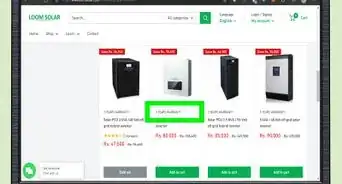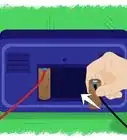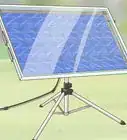This article was co-authored by Guy Gabay. Guy Gabay is a Solar Energy Contractor and the CEO of AmeriGreen Builders, a full-service solar energy, roofing, HVAC and window installation company based in the greater Los Angeles, California region. With over eight years of experience in the construction industry, Guy leads the AmeriGreen team focusing on bringing an educational approach to energy efficient home upgrades. Guy holds a B.S. in Marketing from California State University - Northridge.
There are 8 references cited in this article, which can be found at the bottom of the page.
wikiHow marks an article as reader-approved once it receives enough positive feedback. In this case, 93% of readers who voted found the article helpful, earning it our reader-approved status.
This article has been viewed 154,073 times.
Making the switch to solar power is an exciting change that can provide you with lots of savings on your energy bills over the years, not to mention reduce your carbon footprint. We can help you navigate all the steps to choose and install the perfect system for your home.
Steps
Planning Your Solar System
-
1Read your past year’s utility bills to estimate your annual electricity needs.[1] Gather your digital or paper utility bills for every month from the past year. Add up the metered electricity you paid for each month, which is measured in kilowatt hours (kWh), to get the total amount of electricity you use in a year.[2]
- Keep in mind that your bills have other fixed charges like delivery fees from your utility company. You’ll still have to pay these types of fees after you switch to solar power.
- Your solar system installer will use this information to help determine what size of solar electric system to install, so keep it handy as you go through the process of switching to solar power.
-
2Use a solar mapping tool to determine your home’s solar energy potential. There are many free online tools that will provide you with an estimate of how much solar energy your home can produce based on satellite imaging of the property. Go to one of these sites, enter your address, and note down the information the tool spits out, such as the hours of useable sunlight per year and the square footage available for solar panels.[3]
- For example, you can use Google’s Project Sunroof mapping tool here: https://www.google.com/get/sunroof.
Advertisement -
3See if you have 100 sq ft (9.3 m2) of roof for every kilowatt of energy needed. Measure your open roof space and make sure you have enough area for all the solar panels you’ll be installing. About 4 solar panels will generate 1 kilowatt of solar energy and take up 100 sq ft (9.3 m2) of space.[4]
- Remember that these areas of the roof will have to be exposed to the sun, and probably won't be as effective if they're shaded by trees most of the day.[5]
- The average residential solar system is around 5 kilowatts, or 20 solar panels, in size. So, you will probably need approximately 500 sq ft (46 m2) of free roof space in total.
- Keep in mind that the solar installer you hire will take care of the exact calculations and determine the right size of solar electric system for you.
-
4Research government and utility incentives for switching to solar power. Call up your utility company and ask what benefits, such as net metering, they offer to customers who sign a solar power contract with them and connect to their grid. Do a Google search with a term like “government incentives solar power” to bring up different sites that list incentives by area. Take note of any tax breaks, rebates, and other incentives offered by your local or federal government.[6]
- Net metering means that the utility company will pay you or give you credit for any unused solar power your system generates and gives back to the power grid.
- In the USA, for example, the federal government offers a tax credit equal to about 20-30% of the cost of your solar system. State governments may also provide state tax benefits.
- You can use the information to help you determine whether you want to buy or lease your solar system, since many incentives only apply to homeowners who actually own the solar system.
Hiring a Solar Installer
-
1Search for certified solar system contractors in your area. Do a Google search with a term like “licensed solar installers” to find different contractors in your area. Ask friends or family members who have solar electric systems for recommendations if you know anyone who already made the switch to solar power.[7]
- There are online databases of solar contractors that you can search for. For example, if you live in California, look up the “California Solar Initiative Database.”
- In North America, the standard industry certification for solar contractors is from the North American Board of Certified Energy Practitioners.
-
2Talk to at least 3 different installers and get bids on the installation cost. Choose at least 3 certified solar contractors that you found online or were referred to by friends or family. Contact them and ask to receive an estimate of how much it will cost for them to complete the installation of a new solar electric system in your home.[8]
- Make sure each installer you speak to is giving you an estimate for a system that is the same size. For example, ask the companies to provide you with an estimated cost per kilowatt.
- Bids should include the entire cost of everything needed to get your system up and running, such as hardware, labor, connecting to the grid, permits, and sales taxes.
- Feel free to ask contractors you’re considering for references of other clients in the area that you can talk to to help you decide on an installer.
- Additional things you can ask contractors to help you choose one are what warranties they offer, how familiar they are with the permitting process, and how many installations they’ve completed in your area.
-
3Pick a qualified, experienced, and certified solar contractor to work with. Compare bid prices and all the other information you obtained from the solar installers you interviewed. Choose a company that you feel confident in and that has the proper licenses and a good track record.[9]
- If every company you spoke to seems equally as good, you can just base your decision on who gave you the best bid.
Acquiring Your Solar Electric System
-
1Buy the solar system to get the best benefits if you can afford or finance it. Purchasing a solar system is the best way to maximize the financial benefits because things like tax credits normally only apply to homeowners who own their solar systems. Choose to buy if you have the cash to pay for the system outright or if you are able to finance it or get a loan through your bank.[10]
- A solar system includes the solar panels and other vital electrical components. You can buy it directly from your solar installer as part of a package that includes installation and all other costs.
- Make sure you check both the lifetime and the product/materials warranty before you settle on a solar system.[11]
- The average cost to buy and install a 5 kilowatt solar system is around $17,500 USD. This is the price before receiving any tax credits back.[12]
- Keep in mind that if you own your solar system, you will also be responsible for maintenance and repairs, which can add to the cost down the line. However, many installers also offer warranties and affordable maintenance plans.
-
2Lease a solar system if you can’t afford to buy or don’t want to buy a system. Leasing is a good option if you don’t have the cash to purchase the solar panels and system or if you can’t get a loan or finance the purchase through a bank. Choose this option to receive solar power for a flat monthly fee that is based on the amount of electricity the system you install generates.[13]
- Keep in mind that leasing a solar power system means you won’t be eligible for tax benefits.
- It’s important to note that solar lease contracts are usually for about 20 years. After that, you can usually buy the system for a discounted price.
- A solar lease can cost from $50-$250 a month, depending on the size of the system and your location.
- A benefit of leasing a system is that you aren’t responsible for repairs or maintenance. The company you lease it from will take care of all of that.
- Solar system leases are offered by many solar installers. Alternatively, your installer might work with a larger leasing company to acquire the equipment.
-
3Sign a PPA if you want to buy solar energy instead of paying a monthly fee. A PPA (Power Purchase Agreement) is an alternative to leasing a solar system with a different payment method. In this type of an agreement, you agree to the free installation of the solar equipment on your property and agree upon a set price to pay per kWh of energy you purchase back from the system.[14]
- Like leasing a solar system, you will not be responsible for the maintenance and repairs of the system when you sign a PPA.
- Signing a PPA is another option when you can’t afford to buy a solar system. However, unlike leasing, you won’t have the option to buy the system at the end of your contract.
- The average cost per kWh of electricity purchased through a PPA in the USA is $0.11, compared to $0.15 that you would pay per kWh through a utility company. Note that this varies by area and PPAs are not allowed everywhere.
Completing the Installation
-
1Get approval from your homeowner’s association, if applicable. Talk to the association body and ask if you need approval to install a solar electric system. Get any required written permissions from the body before you proceed.[15]
- It's possible to install solar electric systems in rented homes as well if you get permission from your landlord. However, this probably wouldn't make a lot of sense unless you plan on renting the home for the next decade or two.
-
2Make sure your contractor gets all the permits to complete the installation. Solar installers are typically responsible for filling out all the required applications and submitting them to local jurisdictions to get the necessary installation permits. Talk to your contractor to make sure they are doing this and ask if they need anything from you.[16]
- This often involves someone from your local city or area council coming to perform an onsite inspection of your home.
-
3Sign a solar power contract with your utility company. This will allow you to connect your solar electric system to the utility company’s power grid. You’ll also start receiving any benefits the utility company offers, like net metering, once your system is up and running.[17]
- Make sure you read the contract thoroughly and fully understand all the terms, including monthly fees for things like delivery and administration that you’ll still have to pay.
-
4Oversee your solar installer as they put in the system and connect it to the grid. Your chosen solar contractor will take care of everything, including orienting and tilting the solar panels to maximize daily solar energy intake. Installation usually only takes a few days, sometimes as few as 3, so you’ll be enjoying your new solar power soon.[18]
- Make sure you get all the solar system documentation from your contractor, including warranty and maintenance agreement information.
Community Q&A
-
QuestionI have a method 2 system. How do I connect it to the grid to take advantage of the extra production for a power company pay check after my batteries are charged?
 Community AnswerWork it out with an Electrician and your Public Utility, it doesn't just happen.
Community AnswerWork it out with an Electrician and your Public Utility, it doesn't just happen. -
QuestionWhat is pure sine wave?
 Community AnswerThis just means the electricity is clean and has extremely little or no disturbances in its frequency. Very similar to tuning in a radio station, think of the non-stations or static between radio stations as non-sine or "dirty" electricity.
Community AnswerThis just means the electricity is clean and has extremely little or no disturbances in its frequency. Very similar to tuning in a radio station, think of the non-stations or static between radio stations as non-sine or "dirty" electricity. -
QuestionWhat is the approximate cost of solar powering my home?
 Randy SchwankeCommunity AnswerThe cost of setting up a solar home varies depending on the needs of the family and what it's going to be powering. You will need to figure the amount of time certain things will be used as well. You will also need several deep cell batteries on which power can be stored and drawn upon. You do not want to run the batteries more than 50% of their capacity; more than 50% will shorten the life of the battery. The other expense that must be calculated is the power inverter(s). There are two different types, and you need to figure out if you will need the pure sine wave or not. Sensitive items (i.e. PC's, Tablets, etc.) need the pure sine wave to avoid damaging the components.
Randy SchwankeCommunity AnswerThe cost of setting up a solar home varies depending on the needs of the family and what it's going to be powering. You will need to figure the amount of time certain things will be used as well. You will also need several deep cell batteries on which power can be stored and drawn upon. You do not want to run the batteries more than 50% of their capacity; more than 50% will shorten the life of the battery. The other expense that must be calculated is the power inverter(s). There are two different types, and you need to figure out if you will need the pure sine wave or not. Sensitive items (i.e. PC's, Tablets, etc.) need the pure sine wave to avoid damaging the components.
Warnings
- Make sure that all the installation and electrical work for your solar electric system is performed by licensed contractors.[20]⧼thumbs_response⧽
References
- ↑ Guy Gabay. Solar Energy Contractor. Expert Interview. 4 August 2020.
- ↑ https://www.consumer.ftc.gov/articles/0532-solar-power-your-home
- ↑ https://www.energy.gov/energysaver/planning-home-solar-electric-system
- ↑ https://www.washingtonpost.com/lifestyle/home/considering-getting-solar-panels-here-are-the-right-questions-to-ask/2018/03/09/3190c71a-20c0-11e8-94da-ebf9d112159c_story.html
- ↑ Guy Gabay. Solar Energy Contractor. Expert Interview. 4 August 2020.
- ↑ https://www.consumer.ftc.gov/articles/0532-solar-power-your-home
- ↑ https://www.sce.com/residential/generating-your-own-power/solar-power
- ↑ https://www.energy.gov/energysaver/planning-home-solar-electric-system
- ↑ https://www.energysage.com/solar/decision-guide/how-to-choose-a-solar-installer/
- ↑ https://www.energy.gov/energysaver/planning-home-solar-electric-system
- ↑ Guy Gabay. Solar Energy Contractor. Expert Interview. 4 August 2020.
- ↑ https://www.solarreviews.com/solar-panels/solar-panel-cost/
- ↑ https://www.energy.gov/energysaver/planning-home-solar-electric-system
- ↑ https://www.energy.gov/energysaver/planning-home-solar-electric-system
- ↑ https://www.consumer.ftc.gov/articles/0532-solar-power-your-home
- ↑ https://www.sce.com/residential/generating-your-own-power/solar-power
- ↑ https://www.qld.gov.au/housing/buying-owning-home/energy-water-home/solar/get-started-solar
- ↑ https://www.energy.gov/energysaver/planning-home-solar-electric-system
- ↑ https://www.energy.gov/energysaver/planning-home-solar-electric-system
- ↑ https://www.qld.gov.au/housing/buying-owning-home/energy-water-home/solar/get-started-solar
About This Article
If you want to solar power your home, consider installing a grid system, as these will make you eligible for tax credits, plus you’ll be able to sell your excess power back to the power company. To install a grid system, contact a solar panel installation professional, as most benefits require professional installation. Make sure to look into solar power incentives available in your area and take note of any particular solar panel brands or other equipment you need to use in order to qualify for tax credits. Once your solar panels are set up, contact your power company to install any extra power meters that might be necessary. For more advice, like how to install an independent solar power system, scroll down.
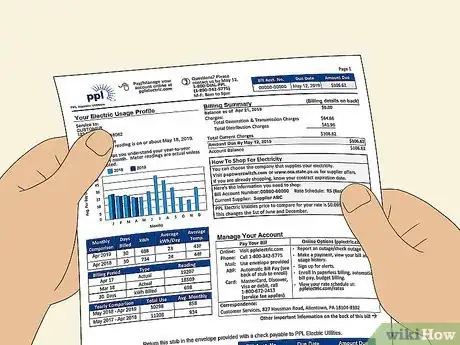

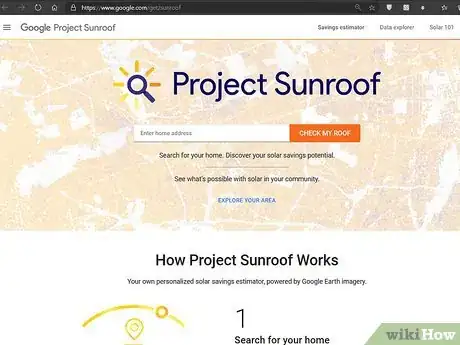
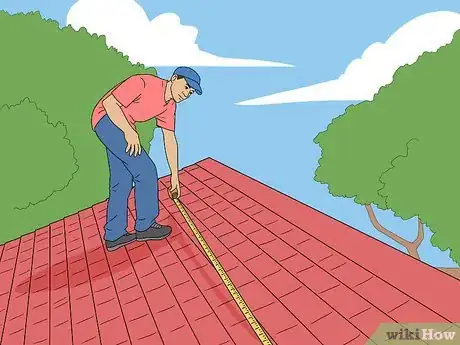

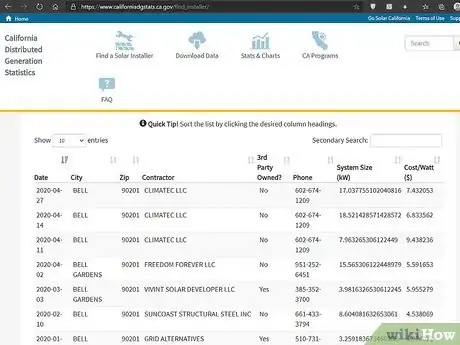
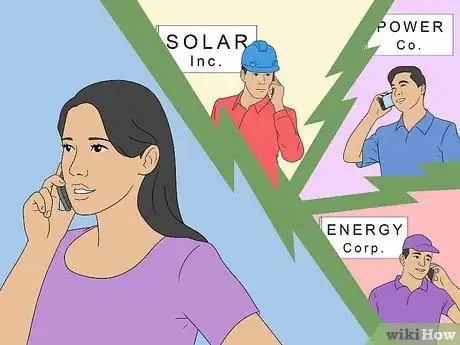

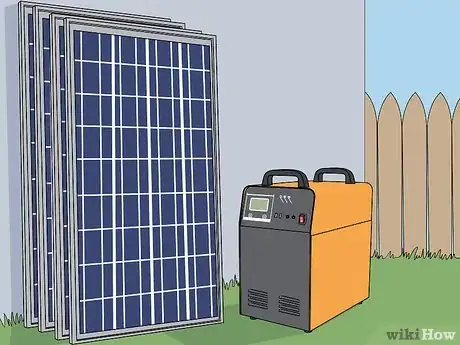
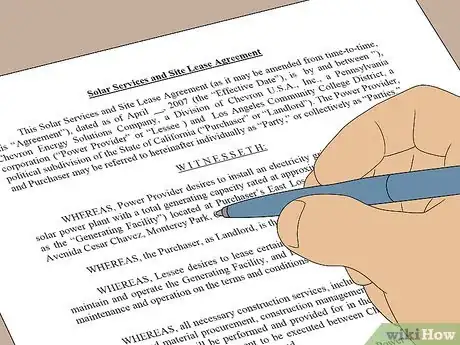
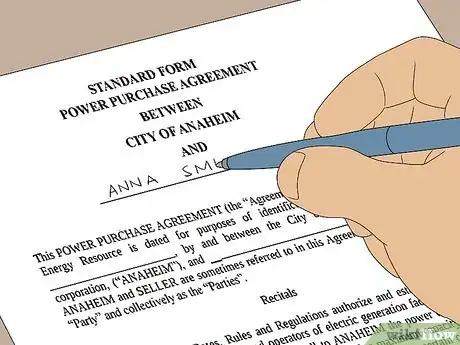


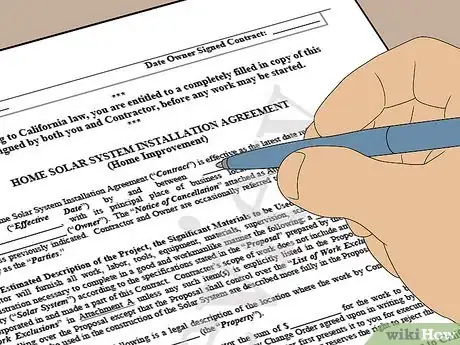
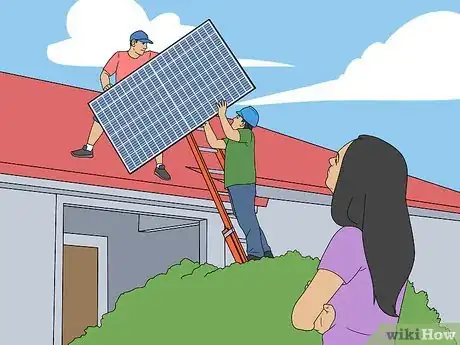

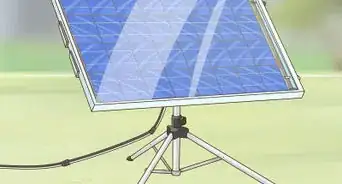
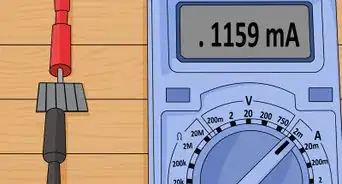
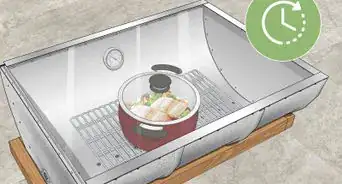
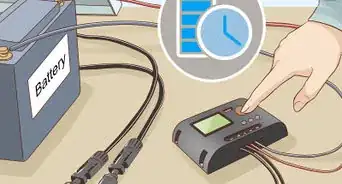
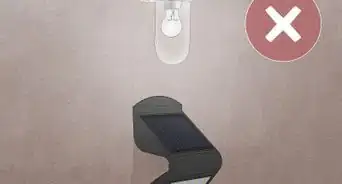
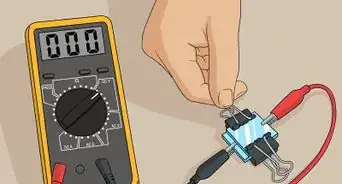
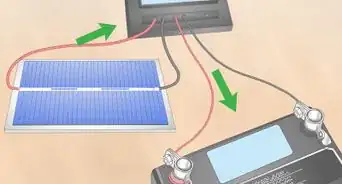


-Step-12-Version-2.webp)
-Power-Generator-Step-11-Version-2.webp)

